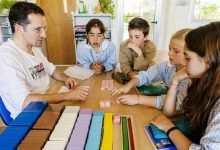How School Architecture Is Evolving
When you think of a classroom, you probably picture a rectangular space with rows of desks. However, the rigidity and conformity in educational design is changing as our understanding of childhood evolves. In this article, we’ll examine how school architects are responding to the challenges of child-centred design.
Creating Home-Like Environments
Primary and high schools are leading the way towards creating more home-like interiors. Schools like the école de l’Étincelle in Canada prioritise welcoming spaces where students feel comfortable and supported in their learning. This represents a significant shift in how classrooms are designed for collaborative learning.
A Comfortable Sense of Scale
Entering a large educational environment can often seem overwhelming for young children, which can lead to anxiety and discomfort. Design that scales to a relatable size becomes welcoming rather than overwhelming, encouraging children to explore and learn through play.
Playful Design that Feeds the Imagination
Rigid shapes and structures are the enemy of curiosity. School architects like https://www.quattrodesign.co.uk/sectors/school-education-architects are reimagining spaces with playful and organic designs incorporating learning zones, vibrant colours, and comfortable shapes. Plenty of natural light is used to brighten interiors and make the design more sustainable and welcoming, encouraging imaginative learning.
Flexible Multifunctional Spaces for Personalised Learning
School architects are also embracing the need for personalised learning, with spaces that can be transformed to suit various needs. Prioritising students’ learning requirements creates a dynamic experience that reflects the diverse way modern students acquire knowledge through one-to-one and digital experiences.
Natural and Multisensory Learning
Incorporating natural elements into school design blurs the lines between indoor and outdoor learning Multisensory elements transform learning into a collaborative experience that can take place anywhere. This design approach means that every corner of the school is an educational space, and no space is wasted.
Learning and Personal Development, Anytime, Anywhere
Breaking away from standard classroom rigidity allows your school to foster an environment that balances learning with personal development, giving students the space to reflect on their studies. This design approach reflects the idea that learning and personal development can happen anywhere, outside the confines of classrooms and timetables.






